Understanding WUI Codes in Washington State
Does the Wildlife Urban Interface affect Washington State?
The IWUIC has been adopted in 94 counties and 850 jurisdictions across 24 states and statewide in 5 US States: Montana, Nevada, Pennsylvania, Utah, and Washington (March 2024)
Resources In Washington State
- Chemco/SaferWood Website
- The Merchant Magazine, May 2023, Watkins ad page 39
- Washington State Wildland Urban Interface (WUI) Story Map
- Washington State Building Code Council WUI Maps
- Building Industry Association of Washington (BIAW) — What in the WUI?!
- International Code Council (ICC) –What is WUI—Website
- ICC Wildland-Urban Interface Code, 2021 (IWUIC 2021)
- Up.Codes website by Jurisdiction for Wildland-Urban Interface Code, 2021 (IWUIC 2021)
Compliance with Wildland-Urban Interface (WUI) Codes in Washington State
The specific requirements for compliance with Wildland-Urban Interface (WUI) codes in Washington State may vary depending on the risk level of the property, but generally include:
- Defensible space: Property owners must create and maintain a defensible space around their structures, which is an area free of flammable vegetation and other materials that could fuel a wildfire.
- Fire-resistant building materials: Structures built in high-risk areas must use fire-resistant building materials, such as metal roofing, tempered glass windows, and non-combustible siding.
- Ignition-resistant construction: Structures must be designed and constructed to resist ignition from external heat sources, such as embers from a wildfire.
- Access and water supply: Structures must be accessible to fire vehicles and equipped with a reliable water supply for firefighting.
- Emergency plans: Property owners must have an emergency plan in place that includes evacuation procedures and communication plans with local fire departments.
- Fire prevention: Property owners must take measures to prevent wildfires, such as using responsible fire practices and properly disposing of smoking materials.
Compliance with WUI codes in Washington State is typically enforced by local building departments and fire departments. Property owners in high-risk areas are encouraged to work with professionals, such as contractors, architects, and landscape architects, to ensure compliance with WUI codes and reduce their risk of wildfire damage.
How WUI Codes Affect Construction and Development in Washington State
The Wildland-Urban Interface (WUI) codes in Washington State can have a significant impact on construction and development in high-risk areas. Here are some ways WUI codes can affect construction and development:
- Site selection: Developers must carefully select sites for new construction to minimize wildfire risk. High-risk areas may be subject to more restrictive zoning regulations or building codes.
- Building design: Structures in the WUI must be designed and constructed to resist ignition from external heat sources, such as embers from a wildfire. This may require the use of fire-resistant building materials and modifications to design and layout.
- Access and water supply: Structures in the WUI must be accessible to fire vehicles and equipped with a reliable water supply for firefighting. This may require upgrades to roads, driveways, and water systems.
- Permitting and inspection: Structures in the WUI must comply with specific permitting and inspection requirements outlined in the WUI codes. This may require additional review and approval from local building departments or fire departments.
- Landscape design: Landscaping in the WUI must be designed to reduce the risk of wildfire damage, such as by using fire-resistant plants and creating defensible space around structures. This may require modifications to existing landscaping or changes to the design of new landscaping.
- Compliance enforcement: Compliance with WUI codes is typically enforced by local building departments and fire departments, and failure to comply can result in fines, penalties, or other consequences.
Overall, the WUI codes in Washington State are intended to reduce the risk of wildfire damage to structures built in high-risk areas. Compliance with these codes may require additional planning, design, and construction considerations, but can ultimately help protect property and save lives in the event of a wildfire.
How to Determine Your Property’s WUI Designation in Washington State
- Visit your State’s Department of Natural Resources (DNR) website and locate the WUI map for your area.
- Enter your address or parcel number to determine if your property is located within the WUI.
- If your property is located within the WUI, determine the risk level by checking the color-coded zones on the map.
- Contact your local fire department or building department for more information on WUI codes and requirements in your area.
- Consider hiring a professional to conduct a wildfire risk assessment of your property to help determine the best ways to reduce your risk of wildfire damage.
- Take steps to mitigate your risk of wildfire damage, such as creating defensible space around your property, using fire-resistant building materials like SaferWood and keeping your property free of debris that could fuel a fire.
The Benefits of WUI
- Safety: ensure that structures built in high-risk areas are designed to minimize the risk of wildfire damage.
- Compliance: Building codes require compliance with WUI codes in high-risk areas.
- Insurance: Many insurance companies require that structures built in high-risk areas comply with WUI codes in order to obtain coverage.
- Resale value: Homes and other structures built in compliance with WUI codes may have a higher resale value.

